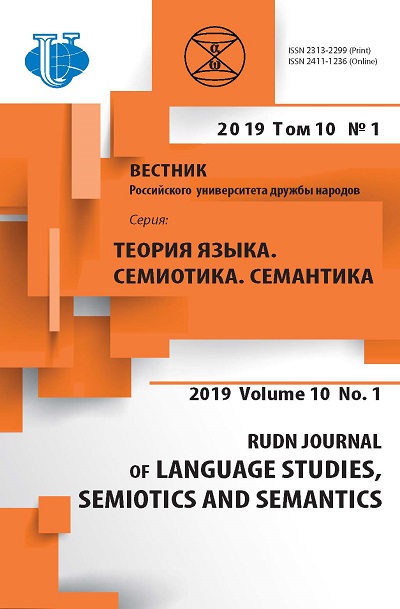EFFECTIVENESS VS. EFFICIENCY: AN ANALYSIS OF VALENCY AND COLLOCABILITY IN A TECHNICAL CONTEXT
- Authors: Filyasova Y.A1
-
Affiliations:
- Saint-Petersburg Mining University
- Issue: Vol 10, No 1 (2019)
- Pages: 187-196
- Section: MISCELLANEA: SYSTEMIC APPROACH IN THEORETICAL AND APPLIED DESCRIPTIONS OF LANGUAGE
- URL: https://journals.rudn.ru/semiotics-semantics/article/view/20902
- DOI: https://doi.org/10.22363/2313-2299-2019-10-1-187-196
Cite item
Full Text
Abstract
Abatract. The article presents the results of a lexico-syntactic analysis of valency and collocability of English words, related to one semantic group: effectiveness and efficiency . The aim of the research was to study the ability of these words to syntactically and lexically contact with other words, taking into consideration certain difference between their lexical meanings. The objectives included determining semantic variations and analysis of word classes in the left and right contexts. The material, 177,144 words, comprised 700 article titles and abstracts from seven international journals with geological and petroleumrelated specializations. Methods of study involved continuous sampling, classification, and analysis of lexical meanings of relevant words. It was found that the frequency of effectiveness was 40% higher than that of efficiency. Both of them had similarities in syntactic valency: they occurred in identical syntactic structures, however, with different rates of occurrence. The difference is the most obvious in such syntactic structures as N(E)+of+N - characteristic of effectiveness, and V+A+N(E) - specific to efficiency. A typical example of effectiveness was the effectiveness of the proposed method , while that of efficiency - improve production efficiency . Effectiveness collocated more often with method-related notions, whereas efficiency - with processes. The gained data correlate with the definitions: effectiveness has a wider semantic field (which explains a higher rate of its occurrence) and is oriented towards result, while efficiency implies process and has an additional technical meaning. The data can be used in the practice of teaching English as a second language for students with technical specializations and technical translation.
About the authors
Yulia A Filyasova
Saint-Petersburg Mining University
Author for correspondence.
Email: phill.yield@gmail.com
Candidate of Philology, Associate Professor, Department of Foreign Languages
21st Line, 2, Vasilievsky Island, St. Petersburg, Russia, 199106References
- Ginzburg, R.S., Khidekel, S.S., Knyazeva, G.Y., & Sankin, A.A. (1979). A course in modern English lexicology. Moscow: Higher School. (In Russ.).
- Filipec, J. (1994). Lexicology and lexicography: Development and state of the research. In: Prague school of structural and functional linguistics, Ph.A. Luelsdorff (Ed). Amsterdam: John Benjamins B.V. pp. 163-185.
- Yudina, N.V. (2006). On some new phenomena in lexeme collocating in the modern Russian language (based on attributive-substantive complexes). Izvestia: Herzen University Journal of Humanities and Science, 16, 75-84. (In Russ.).
- Katznelson, S.D. (1987). To the notion of types of valency. Voprosy Jazykoznanija (Topics in the study of language), 3, 20-32. (In Russ.).
- Kobrina, N.A. (2007). Is there any regular correspondence between the lexical meaning of a verb and its grammatical paradigm? Issues of Cognitive Linguistics, 4, 40-43. (In Russ.)
- Paducheva, E.V. (2001). About the structure of the semantic field “perception”. Topics in the Study of Language, 4, 23-44. (In Russ.).
- Kalinina, O.N. (2008). Unity of the notions valency, function and position. Izvestia: Herzen University Journal of Humanities and Science, 69, 111-114. (In Russ.).
- Stowell, T.A. (1981). Origins of phrase structure [abstract of dissertation]. Massachusetts: Massachusetts Institute of Technology.
- Chomsky, N. (1965). Aspects of the Theory of Syntax. Cambridge, Massachesetts: MIT Press.
- Kobrina, N.A., Korneeva, E.A., Ossovskaya, M.I. & Guseeva, K.A. (2004). Grammar of the English language: Morphology. Syntax: A coursebook. St. Petersburg: Union.
- Ermilova, M.L. (1993). Collocability of phraseological units with words, Vestnik of Saint-Petersburg University, 4, 78-80. (In Russ.)
- Mitrofanova, I.I. & Chernova, N.V. (2013). Work on lexical combinability based on political texts in foreign audience. RUDN Journal of Russian and Foreign Languages Research and Teaching, 3, 39-43. (In Russ.)
- Novikov, L.A. (2011). The reflection of stylistic synonymy in the context of literary works, RUDN Journal of Language Studies, Semiotics and Semantics, 2, 49-53. (In Russ.)
- Arnold, I.V. (2012). Lexicology of modern English language: A coursebook. Moscow: FLINTA.
- Filyasova, Y.A. (2015). Continuous and end-of-module assessment system modelling for secondlanguage communicative competence evaluation. RUDN Journal of Russian and Foreign Languages Research and Teaching, 4, 220-223. (In Russ.)
- Arutyunova, N.D. (1976). Sentence and its meaning: Logical and semantic issues. Moscow: Nauka. (In Russ.)
- Journal of Petroleum Geology. URL: https://onlinelibrary.wiley.com/journal/17475457 (accessed: 5.07.18).
- Petroleum Geoscience. URL: http://pg.lyellcollection.org/ (accessed: 8.07.18).
- Journal of Unconventional Oil and Gas Resources. URL: https://www.journals.elsevier.com/ journal-of-unconventional-oil-and-gas-resources (accessed: 10.07.18).
- Journal of Petroleum Science and Engineering. URL: https://www.journals.elsevier.com/ journal-of-petroleum-science-and-engineering (accessed: 12.07.18).
- Marine and Petroleum Geology. URL: https://www.journals.elsevier.com/marine-andpetroleumgeology (accessed: 15.07.18).
- Petroleum Exploration and Development. URL: https://www.journals.elsevier.com/petroleumexploration-and-development (accessed: 1.07.18).
- Petroleum Science. URL: https://www.springer.com/earth+sciences+and+geography/mineralogy+ %26+sedimentology/journal/12182 (accessed: 7.07.18).
- Macmillan Dictionary. URL: https://www.macmillandictionary.com/ (accessed: 7.07.18).
- Cambridge Dictionary. URL: https://dictionary.cambridge.org/ (accessed: 7.07.18).
- Merriam-Webster Dictionary. URL: https://www.merriam-webster.com/ (accessed: 7.07.18).
- Oxford Dictionary. URL: https://en.oxforddictionaries.com/ (accessed: 7.07.18).













